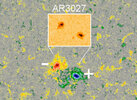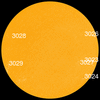SOLAR CYCLE 25 ACTIVITY REPORT MAY 31
▪︎Geospace quiet despite high speed solar wind >500 km/sec
▪︎Latest Solar wind speed record: 522.7 km/sec (03:57 UTC May 31 )
▪︎density: 7.60 protons/cm3
▪︎Neutron Counts today: 3.6 % Elevated
▪︎Sunspot number: 40 (SN 42 may 30)
▪︎Geomagnetic conditions now Kp=2 quiet
▪︎No extraordinary events in the last 24h. ▪︎AR3023, AR3024 and AR3025 All of these sunspots are stable and quiet. There is only a slight chance of flares today.
▪︎Geospace quiet despite high speed solar wind >500 km/sec
▪︎Latest Solar wind speed record: 522.7 km/sec (03:57 UTC May 31 )
▪︎density: 7.60 protons/cm3
▪︎Neutron Counts today: 3.6 % Elevated
▪︎Sunspot number: 40 (SN 42 may 30)
▪︎Geomagnetic conditions now Kp=2 quiet
▪︎No extraordinary events in the last 24h. ▪︎AR3023, AR3024 and AR3025 All of these sunspots are stable and quiet. There is only a slight chance of flares today.








